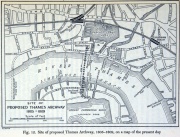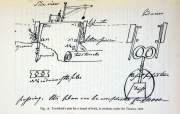Thames Drift Tunnel
Project promoted by the Thames Archway Co
In 1805 Robert Vazie, a Cornish engineer, was selected by the company to drive a tunnel under the River Thames at Rotherhithe. Vazie encountered serious problems with water influx and got no further than sinking the end shafts when the directors called in Trevithick for consultation. The directors agreed to pay Trevithick £1,000 if he could successfully complete the tunnel, a length of 1,220 feet.
1807 August. Richard Trevithick takes over as engineer for the project and began driving a small tunnel 5 feet high tapering from 2 feet 6 inches at the top to 3 feet at the bottom.
1807 By 23 December after it had progressed 950 feet when progress was delayed after a sudden inrush of water and only one month later, at 1,040 feet, a more serious inrush occurred. The tunnel was flooded and Trevithick, being the last to leave, was nearly drowned.
Progress stalled and a few of the directors attempted to discredit Trevithick but the quality of his work was eventually upheld by two colliery engineers from the North of England. Despite suggesting various building techniques to complete the project, including a submerged cast iron tube, Trevithick's links with the company ceased and the project was never actually completed.
The first successful tunnel under the Thames would be the Thames Tunnel started by Marc Isambard Brunel three quarters of a mile upstream in 1823 and completed by his son Isambard Kingdom Brunel in 1843.




